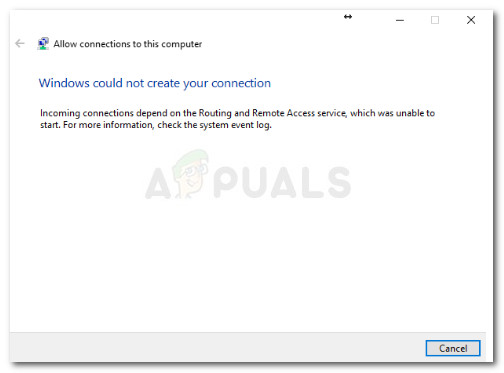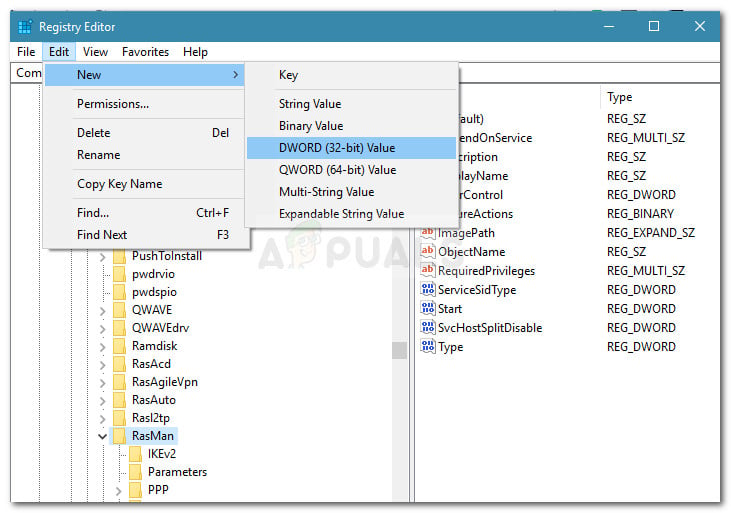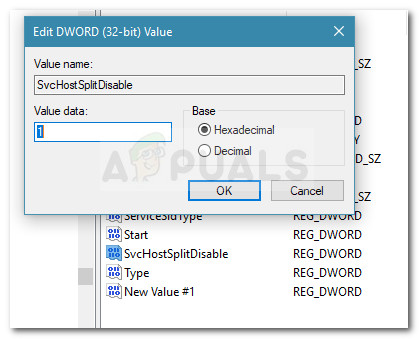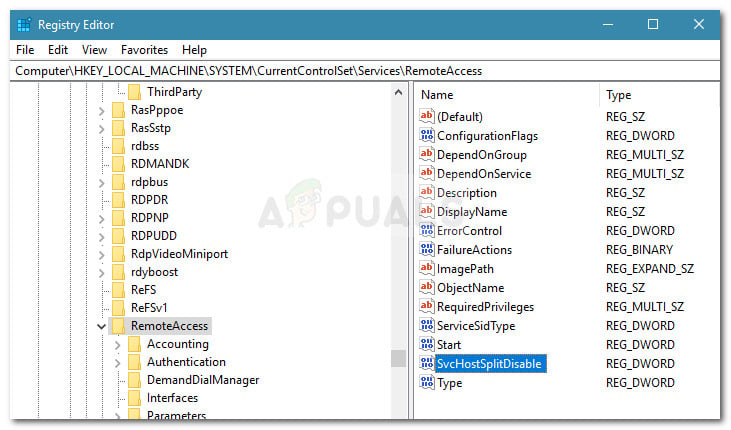Fix: Incoming Connections Depend on the Routing Remote Access
Some users have reported getting the “Incoming connections depend on the Routing and Remote Access service” error when they try to start the RRAS (Routing and Remote Access Service) service. Most affected users report that this issue occurs when they attempt to set up an incoming VPN connection – right after they add the incoming connection and click Next.

The error is not specific to Windows 10 (also reported on Windows 8 and Windows 7) but it’s mostly reported to occur with Insider builds.
What causes the Incoming Connections Depend on the Routing Remote Access error
After investigating the issue and looking at various user reports, we created a list with common culprits that might lead to the apparition of this issue:
- Ongoing incoming connections bug – Microsoft is aware of this issue and has previously released a couple of hotfixes. But as of now, this issue is still reported even on the latest Windows 10 builds. Luckily, this bug can be circumvented with a Registry Editor fix (Method 2).
- An external firewall is blocking the incoming connections – This issue can be caused by an overprotective firewall. Several users have reported that the issue was fixed after they ended up uninstalling their 3rd party security solutions.
How to fix the Incoming Connections Depend on the Routing Remote Access error
If you’re currently struggling to resolve this particular issue, this article will provide you with a list of tested troubleshooting steps. Below you have a collection of methods that other users in a similar situation have used to get the issue resolved.
To ensure that you maximize your chances of success, please start with the first method and follow the rest of them in the order that they are presented. If any method is not applicable to your situation, skip it and continue with the next one below. Let’s begin!
Method 1: Uninstalling 3rd party firewall
Before you move on to the other fixes below, let’s make sure that the issue is not being caused by 3rd party interference. There are a number of reports from users that have been able to resolve the issue after getting rid of their 3rd party firewall.
Apparently, there are a number of overprotective 3rd party solution that will interfere with the creation of new incoming VPN connection using the built-in feature.
To test whether this theory is true, you’ll need to let go of your 3rd party firewall and uninstall it from your system. Keep in mind that disabling the real-time protection will not be effective in resolving the issue since the rules will still remain firmly in place.
To ensure that you’re not leaving any leftover files that might still cause interference, we recommend that you follow the steps below:
- Press Windows key + R to open up a Run dialog box. Then, type “appwiz.cpl” and hit Enter to open Programs and Features.

Run dialog: appwiz.cpl - In Programs and Features, scroll down through the application list and locate your 3rd party antivirus software. Once you do so, right-click on it and choose Uninstall, then follow the on-screen prompts to remove it from your system.
- Follow this guide (here) to ensure that your 3rd party firewall didn’t leave behind any files that might still create interferences.
- Restart your computer and see if the issue has been resolved at the next startup.
If you’re still prevented from creating new VPN connections via the “Incoming connections depend on the Routing and Remote Access service” error, continue down with the next method below.
Method 2: Enabling incoming connections via Registry Editor
There is one particular procedure that is often recommended on Technet forums and seems to have helped a lot of users to resolve the Incoming Connections Depend on the Routing Remote Access error. It involves using the Registry Editor that disables the Svc Host Split service in order to ensure that incoming connections are permitted to be used for Remote Access chores.
Here’s a quick guide on what you need to do:
- Press Windows key + R to open up a Run dialog box. Then, type “regedit” and press Ctrl + Shift + Enter to open the Registry Editor with administrative access. If prompted by the UAC (User Account Control), click on Yes.

Run dialog: regedit - Inside Registry Editor, use the left pane to navigate to the following location: Computer \ HKEY_LOCAL_MACHINE \ SYSTEM \ CurrentControlSet \ Services \ RasMan
- Now move over to the right-hand pane. With the RasMan registry key selected, use the ribbon at the top to create a new Dword value by going to select Edit > New > Dword (32-bit) value.

Create new Dword value Note: If the Dword value SvcHostSplitDisable already exists, skip this step.
- Name the newly created Dword to SvcHostSplitDisable. Make sure to use this exact name, capitals characters included.
- Double-click on SvcHostSplitDisable and set the Base to Hexadecimal and the Value data to 1.

Set Base to Hexadecimal and Value data to 1 - Use the left pane again, to navigate to the following location: Computer \ HKEY_LOCAL_MACHINE \ SYSTEM \ CurrentControlSet \ Services \ RemoteAccess
- Now move back to the right-hand pane. With the RemoteAccess key selected, use the ribbon at the top to create a new Dword by going to Edit > New > Dword (32-bit) value.
Note: If a SvcHostSplitDisable value is already created, skip straight to the next step below. - Name the newly created Dword to SvcHostSplitDisable.

Name the newly created Dword to SvcHostSplitDisable - Double-click on SvcHostSplitDisable and set the Base to Hexadecimal and the value to 1.
- Close Registry Editor and restart your computer. At the next startup, see if the issue has been resolved by checking whether the same issue occurs when you’re trying to set up an incoming VPN connection.
If the issue is still not resolved, continue with the next method below.
Method 3: Disabling IPv6 interfaces via Command Prompt
Several users have managed to get the issue resolved by editing the registry manually (or automatically) to disable all IPv6 interfaces except for the IPv6 loopback interface.
While this fix managed to fix the issue for a lot of affected users, there’s a major downside – it breaks IPv6 connectivity. If you can live without this inconvenient, follow the steps down below to circumvent the “Incoming connections depend on the Routing and Remote Access service” error by using an elevated Command Prompt to disable all IPV6 interfaces:
- Press Windows key + R to open up a run dialog box. Then, type “cmd” and press Ctrl + Shift + Enter to open an elevated Command Prompt. If prompted by the UAC (User Account Control), click on Yes.

Run dialog: cmd and press Ctrl + Shift + Enter - In the elevated command prompt, insert the following command below and press Enter. This command will add a registry value that will disable all IPv6 interfaces except for the IPv6 loopback interface.
reg add "HKEY_LOCAL_MACHINE\SYSTEM\CurrentControlSet\Services\Tcpip6\Parameters" /v DisabledComponents /t REG_DWORD /d <0x11> /f
Note: You can also replace the 0x11 value from the command above with 0xFF. This will disable all IPv6 components except for the IPv6 loopback interface. Both values are confirmed to be effective in solving this particular issue.
- Restart your computer and see if the issue is resolved at the next startup.




